Cove to Cove: The Black Canyon of the Colorado River
Story by: Candice Kalb
Photos by: Candice Kalb, Logan Foll, Brian Janezic
“Oh, upstream? Strong move” should have been our first warning. Instead, we laughed like hyenas as the third person commented, “something something upstream!” Boldly (and a little ignorantly) thinking that we understood the river better than all those city folks from Vegas. Not to totally discredit ourselves, we understand the flow of water and CFS (cubic feet per second) units that indicate the volume of water moving downstream. However, we did not account for the strength of the wind. Or the lack of water being released by the all-mighty Hoover Dam.

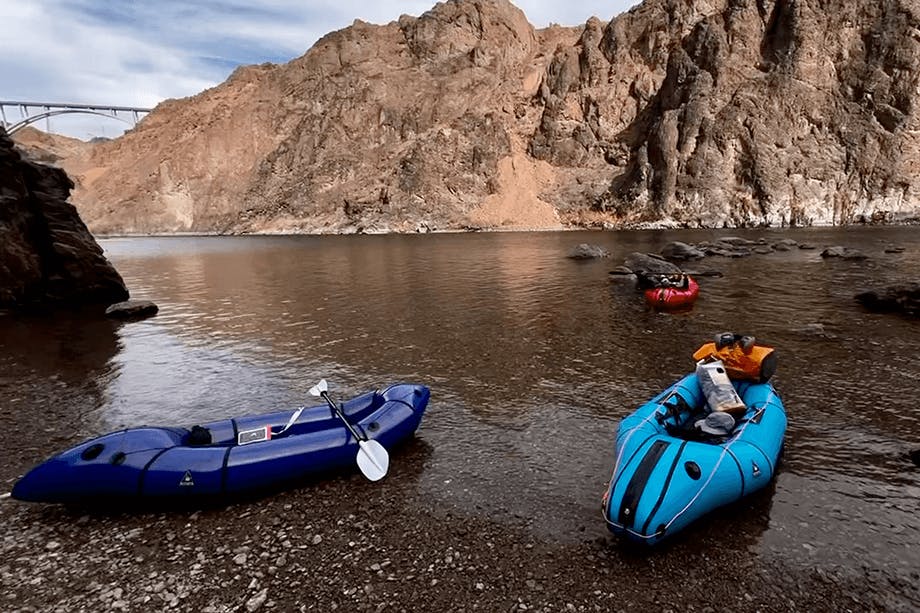
The Hoover Dam, previously known as Boulder City Dam, is one of mankind’s biggest testimonies to natural dominance. Looking up from my pack raft, I felt the enormity of what they were able to achieve. It was a feat of human engineering to help control the unpredictable flooding of farmlands and provide a reliable source of water and electricity to the growing West. (archive) The ripple effect would last well over 100 years and become a hot debate.
The Colorado River is likely the most litigated river in the US. Even its name is a hot debate. Prior to 1921, it was widely known as the Grand, and specific portions were named after various people. Even today, the river community refers to the river as The Grand, which feels more aligned with the river’s vibes than Colorado, Spanish for “color red.” With the inability to even agree on a name, it is no wonder the laundry list of compacts, federal laws, contracts, regulatory guidelines, court decisions and decrees is so long that they are collectively known as the "Law of the River."

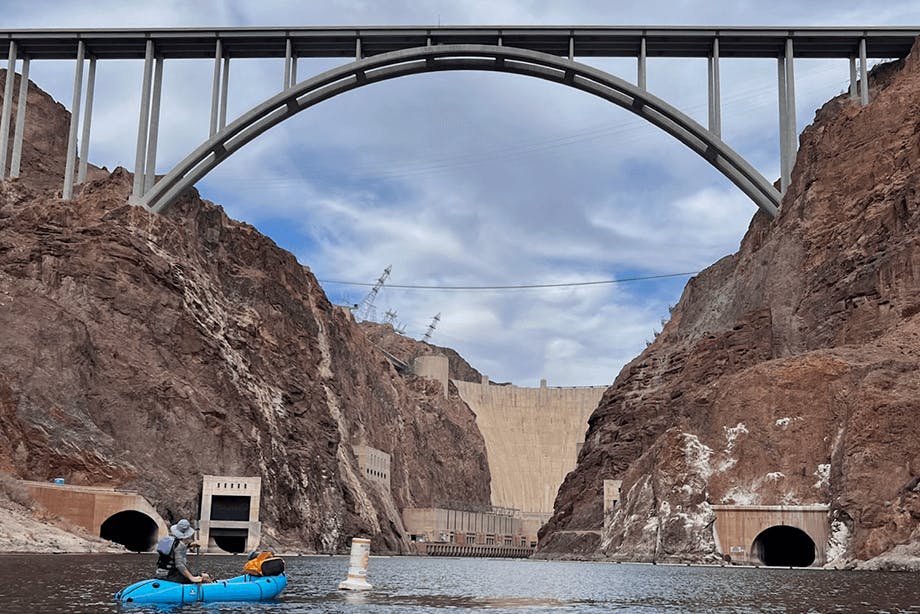
The Colorado Compact is arguably the most important compact for water in the West. It is due for reevaluation in 2026; this 100-year-old agreement, for all intents and purposes, has gone untouched, frozen in nuance and indecision. The Colorado River has been over-allocated to 7 states and supplies water for approximately 40 million people. The river measurements of 100 years ago did not account for climate change, a lack of sustainable management and dramatic water shortages. Similar to our miscalculations of available water, dam-controlled water releases and the elimination of any current.
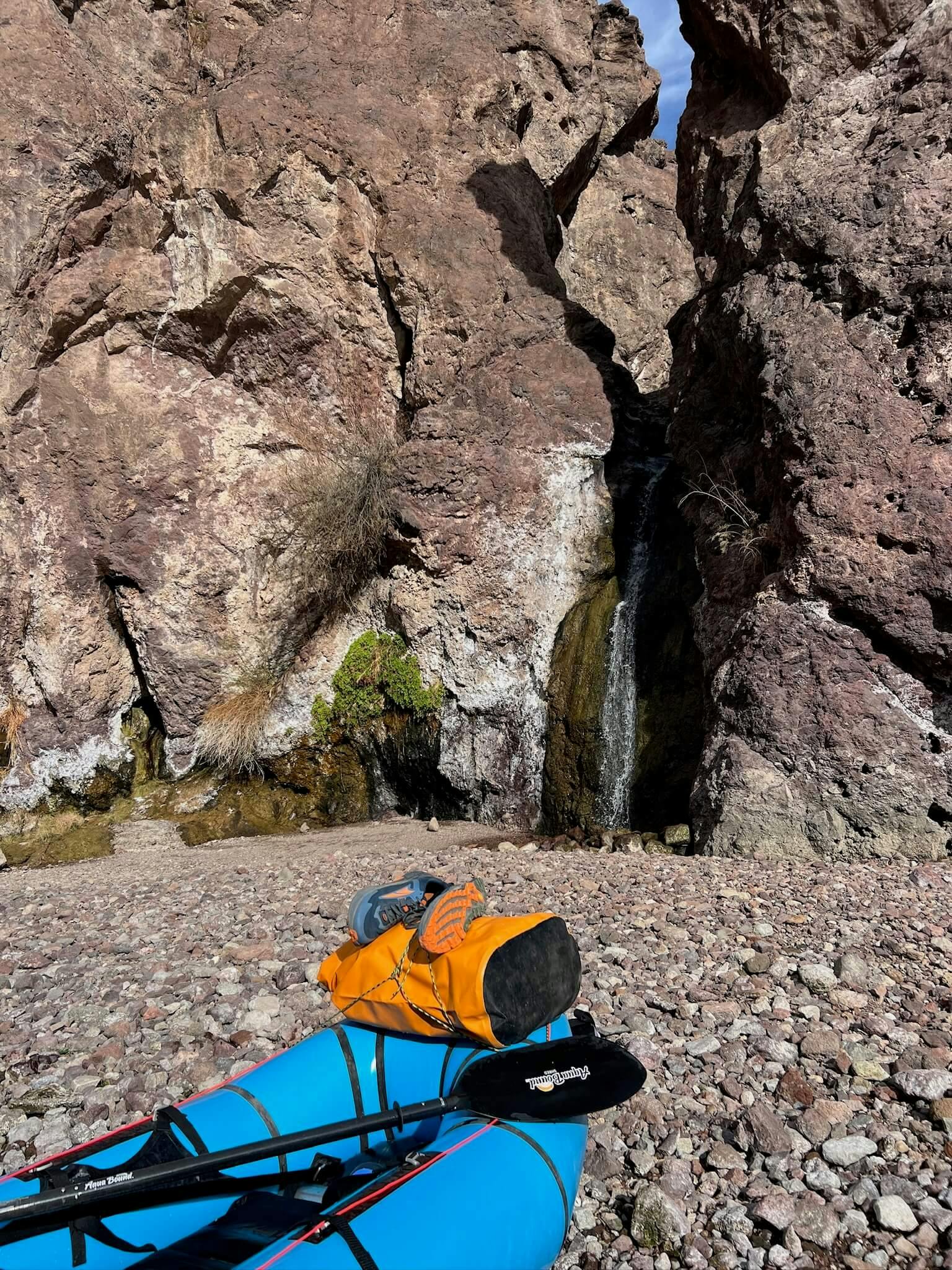
As we walked down the trail, we discussed the nuance of water allocation in the changing times and climate. I shared my interview with John Weisheit, the Colorado Riverkeeper of the Waterkeeper Alliance. We discussed the 20-year drought and difficulties facing the Colorado River. We thought the hike down the canyon with our 35L bags and variety of Alpacka Raft packrafts would be the most difficult part of getting to our 30 river miles. We had been warned about the seven rope-lined, steep granite drops. We anticipated this would be the biggest hurdle and perhaps that is why it felt so mellow. We had mentally braced ourselves for a little scramble, lowering awkward packs and trusting strange ropes.
Packrafting is the way to go on this route. The ability to hike our gear was great. The walk is lovely, you wind through a flower speckled canyon with sneaky barrel cactus growing in the cracks of the steep walls. The roped sections were fun features that added a little spice to the mellow walk.

Starting at the Hoover should have been the warning… As we looked up at this gargantuan symbol of engineering and manpower, we felt the crushing weight of mankind’s hubris.
Honestly, if this were a movie, the whole first day would have been epic foreshadowing.
So many people looked at us as if we were the crazy ones, spouting ominous warnings, “You’re going upriver?” We didn’t know. We didn’t recognize the hubris of our own.
I need you to imagine the most peaceful emerald-clear waters, barely a ripple, the quiet lapping of water against a blend of red and black canyon walls that reach for the sky. This was our first afternoon. The calm of a river tamed into a lake, the water-stained “bathtub rings” of previous levels reaching further and further up the canyon walls.
That first day was filled with laughter as we passed packs down steep boulders and used ropes to climb down the canyon. We leisurely paddled up the canyon and nearly broke our necks, looking up at a massive wall of concrete separating us from the 7.735 cubic miles of Lake Mead. Our bodies were warm from a brief step into the sauna cave, formed when miners hit a hot spring, rendering their prospective mine shaft useless.
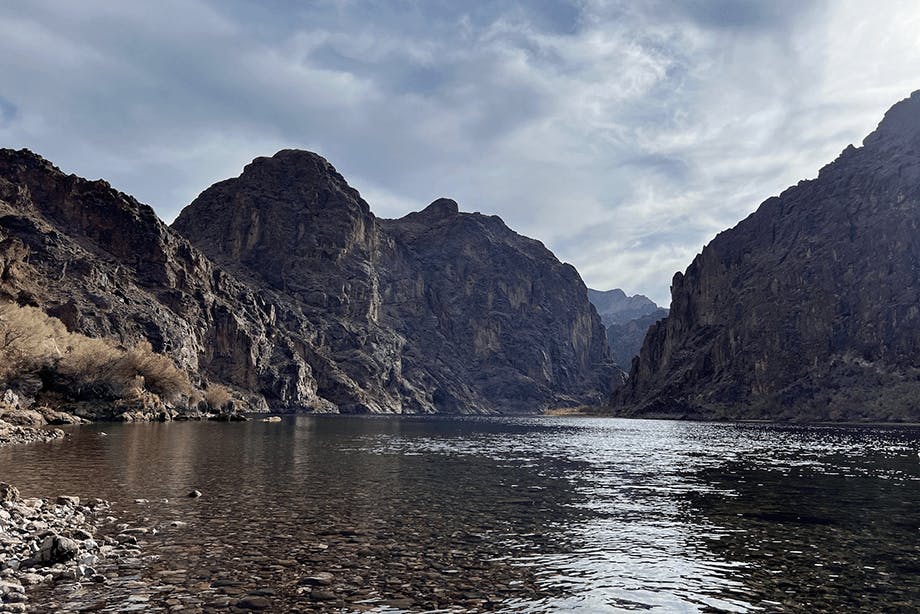
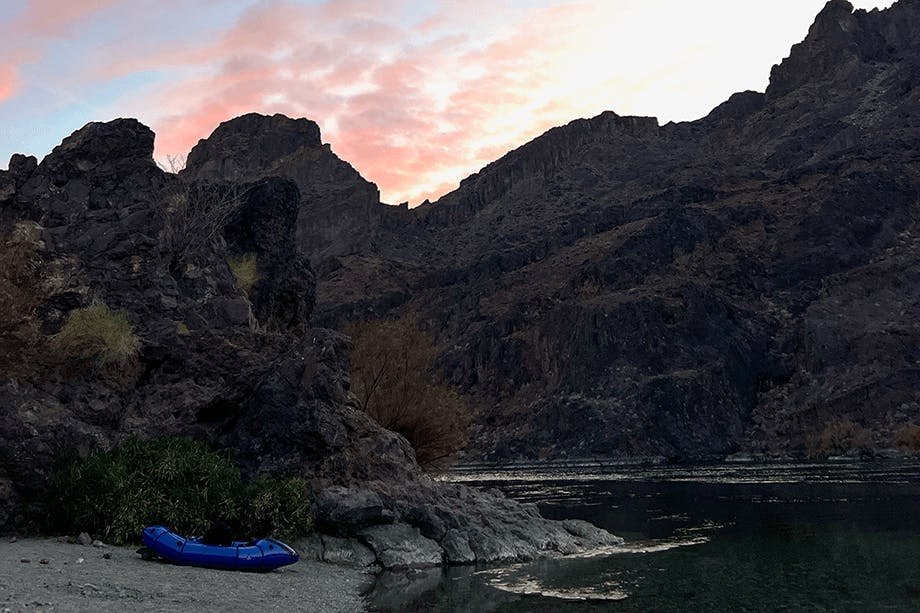
We thought we understood that the river flowed down the canyon as most rivers do. This is no ordinary river. It has been tamed into a lake in an incredibly windy canyon. The winds were supposed to be present but nothing wildly out of the ordinary. Which was exactly what we received that first day as we turned from the sauna cave to head south, down canyon, down river.
Paddling five river miles through the gorgeous Black Canyon was a delight. The canyon shifts from sheer walls, as if we were paddling between books on a library shelf, to open expanses of rough rocky hills, resembling clumpy moon sand poured from above. The variety of plants that can grow in the tiny cracks and ledges provided a scavenger hunt. The Fish Hook Barrel Cactus was just rare enough that it became my favorite “I spy.”
Sunset was coming quickly, and we spotted Ringbolt Canyon just in time for a soak and set up camp before dark. Arizona Hot Springs or Ringbolt Hot Springs is accessible by river or with a quick 3-mile hike down a wide wash and through a stunning canyon. Hikers get the extra treat of checking out petroglyphs and dry falls on their way back to the parking lot. The hot springs are 3-4 tiers of pools varying in temperature, supported by sandbags. From the river, you wind up the trail to a metal staircase that was recently installed by national park employees; the previous ladder had rusted, making these pools inaccessible. The park and volunteers take care of this special space. Please practice leave no trace and be conscious of your impact.



Just after sunrise, we hit the water and had a lovely, peaceful hour.
Then it began.
The wind unexpectedly increased to 20 mph with 30 mph gusts for the next two days and 15 river miles. Although I rowed for a bit during college and have a pretty solid foundation of fitness, this was incredibly difficult paddling. We kept good spirits throughout, but it was a tough go.
This section of the river had more traffic from Willow Beach. At Emerald Cove, we saw a guided day trip in hard rental kayaks. Paddling beneath the catwalk that the hydrographers had to walk daily to measure water flow, depth, silt content and temperature from 1935-1939 was nerve-racking! Multiple times a day, two hydrophraphers would walk along a trail for a mile, cross a cove with a hand-operated cable car, then walk a cliffside catwalk that made my stomach turn just looking up at it. THEN they had to cross the river on another cable car to get to the gauging station.
Day two was beautiful! The stunning rock formations, historic sites, emerald green coves and variety of birds helped as we navigated the river’s less windy spaces.
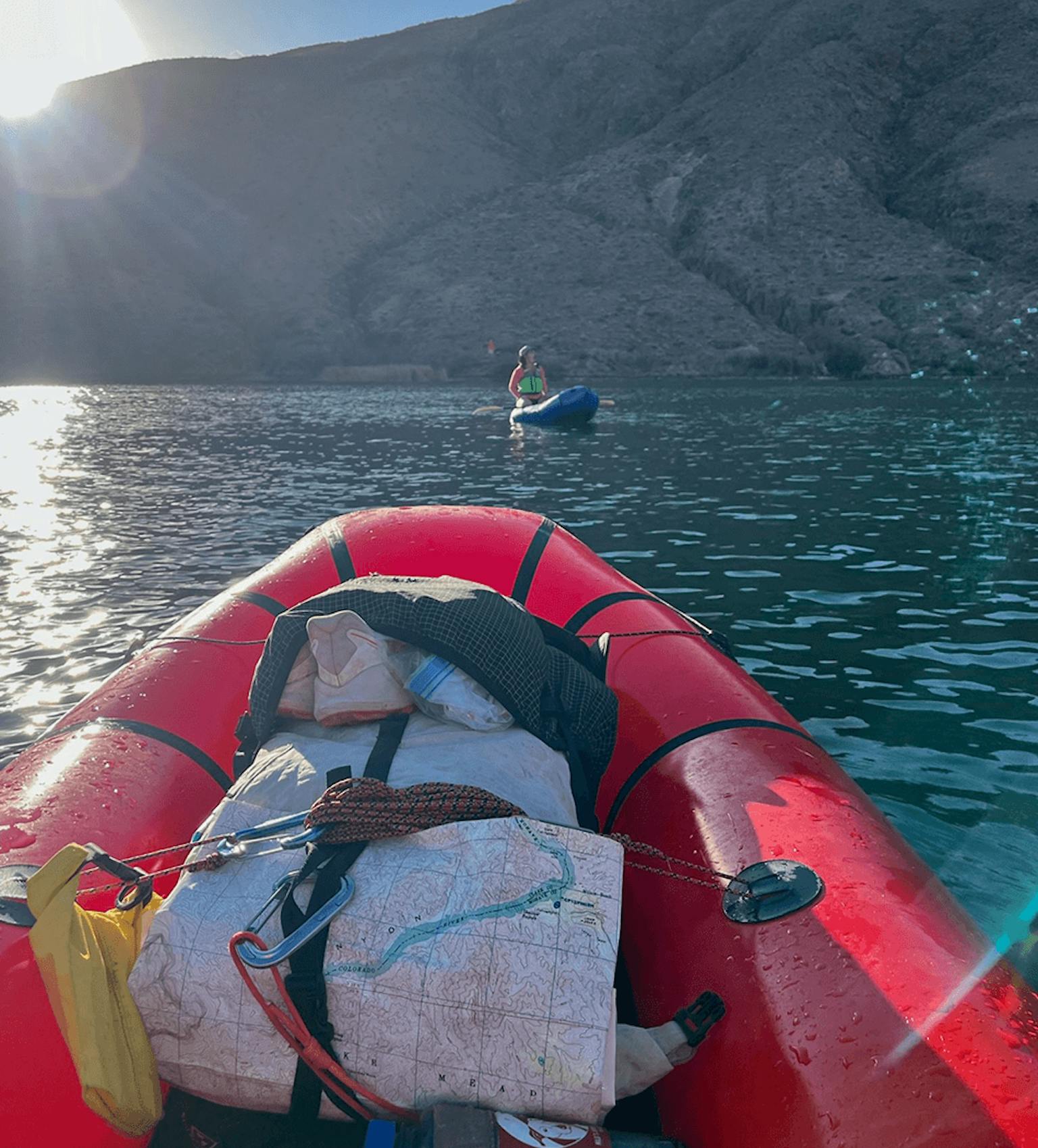
The wind was so strong that we were paddling cove to cove; at times, it felt as if we were on a treadmill. There were a few envious moments when a hard-shelled racing kayak would zoom by, unaffected by the wind. We each had a different Alpacka Raft that was weighted differently, as we all packed slightly differently. Pack rafts are notoriously bad in that kind of wind, but we were able to pack them to better stabilize. Plus, the once grand river has been dammed into a series of lakes that cosplay as a river. Brian loved the Tandem Tango, sitting in the back and all of his gear in the front, he still had room to stretch his legs. He was pretty stable and the weight was balanced. Logan had a self-bailing Gnarmule that was weighted somewhat evenly. With a small snack bag and layers in the front, he had the perfect setup for long days. I had the Classic, which was weighted a little heavier in the back, making it more difficult to track efficiently. But being able to sit on the back, in the well, or lie across the front was so nice for my little wiggle bottom.
We probably should have taken out at Willow Beach. We were hopeful that the weather reports were correct and that we’d have a chill last day to Placer Cove. We questioned planning to Placer Cove due to the lack of river reports but it would have been totally manageable… if it wasn’t for the wind.
We were pretty tired after fighting the wind all day and we weren’t stoked to keep paddling past Willow to find camp. In less windy conditions, this would have been no problem but we were fighting for river miles. We would have needed to challenge the wind for another 2-3 miles to our planned camp, but our arms were wobbly. We teased that they might just pop out like Mr. Potatohead at any moment. We found a small beach that was honestly in rough shape. It was a party beach, and let’s just say, those that came before did not practice Leave No Trace. We set up bivvies and tents on the cleanest patch, had a whiskey-spiked hot cocoa with dinner, and I fell asleep by 8pm.
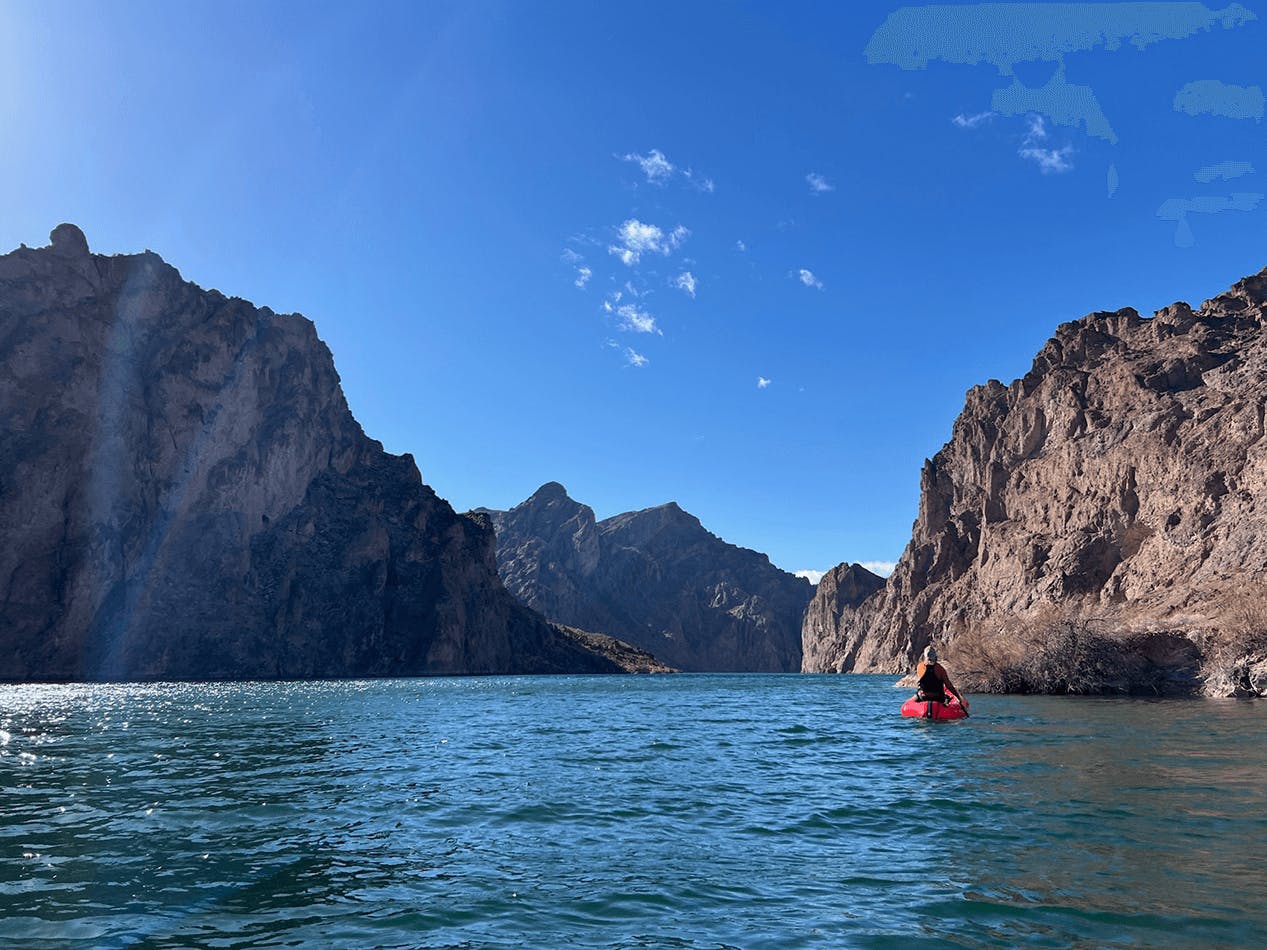
Our dreams of a calm few hours at sunrise were quickly crushed by the ever-persistent wind. It was another 20-mph day with 30 mph gusts. This day was a suffer fest. We made progress, but it was slow, cove-to-cove movements.
In the last 3.5 miles, we entered a cove unlike any other that we had seen. We were surrounded by shades of red when we turned into the Chalk Cliffs. Surrounded by dusty cream cliffs and one small domed mound of shredded coconut, it was perfect for a fancy charcuterie lunch. Warm cheese has never tasted so good. We laughed as we said, “We live here now,” making up silly stories about fishing with webbing and our trusty platypus filtering our water for the next 50 years.
As we left the peaceful cove, the unrelenting wind made the takeout feel impossible to access. The wind held us like an older sibling palming our foreheads while our arms swung. Occasionally, the winds took a break, dropping to just 10 mph. Those moments were tricky pockets of hope, then the wind would howl again. Exhausted, our stomachs would drop, just another false summit. Finally, after holding it together for nearly twenty-five miles… it happened.
Logan snapped; he was tired and no longer having a good time. I snapped, tears falling as I finally admitted that I was not having a good time either. My days as a college rower were long behind me. Brian, however, 5 five-time Cocadona 250 ultra marathon runner who invented a 200-mile race called “The Tucson Question,” had no problem putting his head down and pulling well ahead of us.
We were tired. We were over it. Twenty-five miles against sustained high wind was gnarly. We dreamed of those initial five miles, during which we laughed, chatted and simply took in the beautiful sights. Dusk was well upon us when we spotted Placer Cove. A mixture of excitement and exhaustion flooded us as we pulled the boats out in silence, slowly packing up. We had a bite of chocolate for a little dopamine and to feel a little more human.
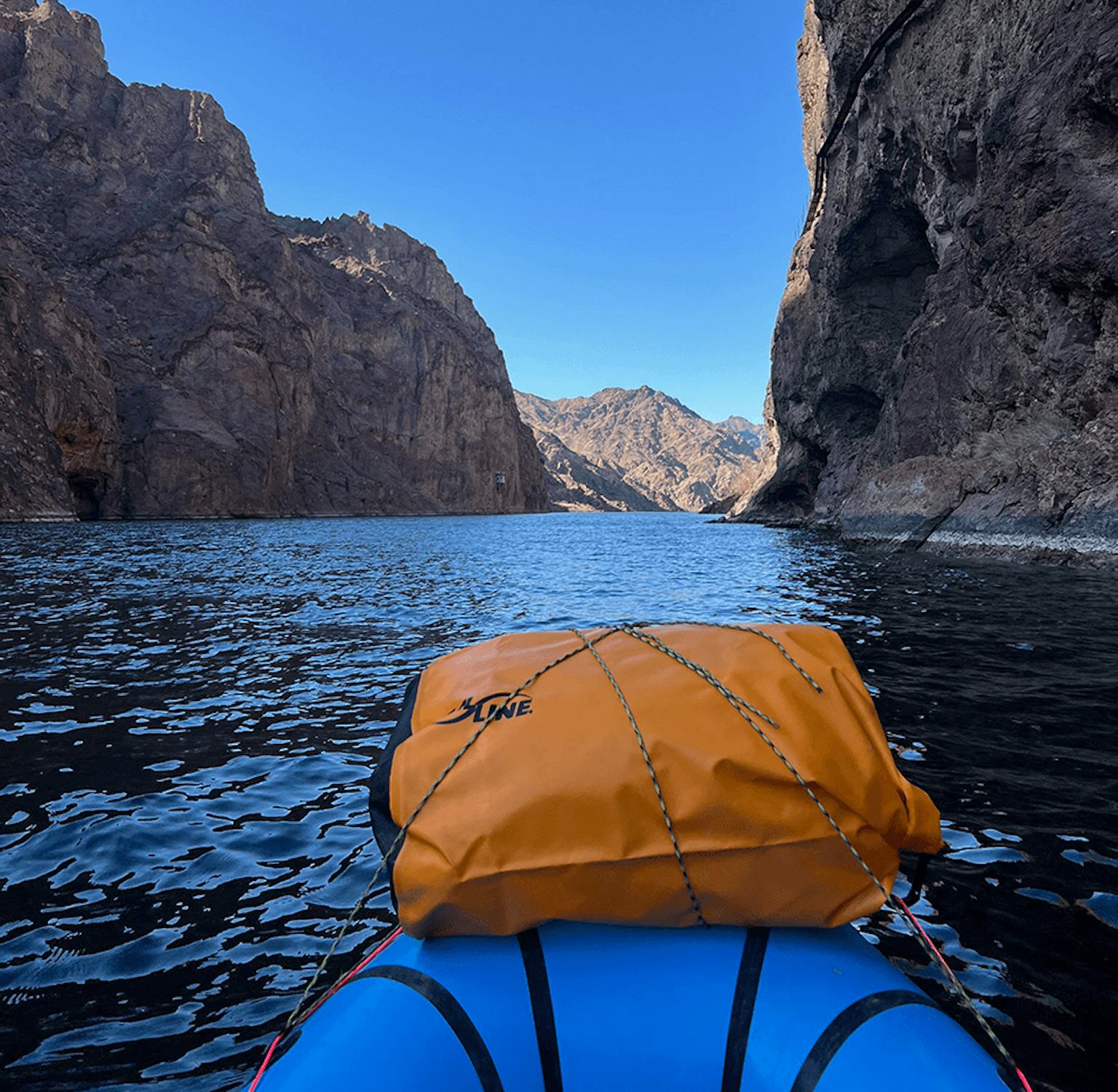
After robotically paddling for hours, we laughed at ourselves with that full-body exhaustion that felt more like quiet wheezing. Silly us for thinking the hardest part of the trip would be those seven rope climbs with our packs. It was a tough paddle, but in the end, we were so proud of how well we did. As we drove not even 400 yards from the takeout, we were already planning our next packrafting trip.
Candice Kalb is a travel writer, photographer, and lifelong adventurer with over 15 years of experience as a wilderness guide, tour director, and storyteller. She shares immersive experiences that highlight the intersection of ecology, culture, and conscious exploration. Currently living on the road in a self-built van, Candice explores the backroads and waterways of North America—camera in hand and curiosity in tow. Follow her journey at chasingcandice.com or on Instagram @chasing.candice.

